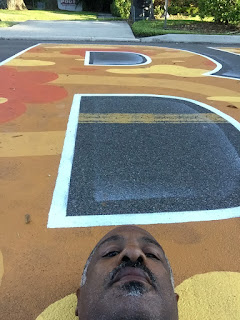Reflections on Juneteenth 2020
It is Juneteenth 2020 in St Petersburg Florida. A planned celebration marking the day of awareness of slavery's end in African American consciousness, has been canceled due to a resurgence of the Covid-19 pandemic. 9th Avenue South, in front of the Dr. Carter G Woodson African American Museum is vacant of celebrants, but reflects their anticipated energy and thirst for positive change, an anticipation that has overtaken the country and the world since George Floyd's brutal fate placed a question mark behind our own. A large colorful rendition of the words, 'Black Lives Matter' has been painted on the street and reflects the belief so emphatically emblazoned by the Major of Washington DC on the avenue leading to the Whitehouse only two weeks earlier. It also reflects some incredible local artistic talent. To me personally, it reflects even more.
My ancestors lived and worked in this area of St. Petersburg. 9th Avenue is the street my Father, Henry Oliver, Jr. grew up on. His first school, Jordan Park elementary, stands a block down the street from the much later African American history museum and other developments that have tried to revive some of the past energy of this neighborhood. The nearest intersection of 22nd Street and 9th Avenue marks what would be considered St. Pete's version of 'Black Wall Street', the Greenwood District of Tulsa Oklahoma thats was a thriving center of black owned businesses until the area was bombed, burnt, and lynched to the ground 99 years ago in 1921.
The year 1921, was about the time my grandfather, Henry Oliver Sr., arrived in St. Petersburg and began numerous types of work that included laying vast sections of brick streets by hand. Some of the remnants of his black/red hands still remain, perhaps beneath the freshly painted asphalt of the mural itself. The Florida sun brought out a beautiful redness in his skin, that acknowledged the joining of African and Native American blood. My grandmother, also of mixed heritage, worked as a head seamstress in the clothing alteration section of a downtown department store. Henry Sr. and his wife Eva owned a home and an adjacent produce market on 9th Avenue. A palm tree they planted still remains, marking the corner of their otherwise unrecognizable property. About one block North and East and deeper in time and obscurity, stood my great grandparents home on Harrington Avenue. Emanuel and Mary Brown, had a garden and kept animals. My father still tells stories of how his grandmother would save a special duck or goose for his nourishment. She would also hold his hand as they walked South on 22nd Street, past numerous black owned businesses, and into then whiter neighborhoods, to a lake where they went fishing together. They were careful to walk on the edge of the curb, to avoid offending a white person who might be traversing the sidewalk.



In the 1970's, highway construction obliterated this neighborhood and my ancestors foothold there. Harrington avenue now lies buried deep beneath the multiple lanes of I-275. Along with my Great grandparents homestead, both my fathers's childhood home and my uncle Eddie's home were demolished as the path for the highway was cut through the black community via eminent domain. All still living, were displaced and relocated. The coming of desegregation, while welcomed as progress towards equality, also further hurt black owned businesses who relied on the critical mass of their adjacency. The visibly concentrated energy of the black community was never quite the same. The federally and locally developed highway plans have been well documented as having been targeted to achieve precisely these results, a reflection of what has happened to black communities in America since first being displaced from Africa itself. That displacement also involved a 'Highway'. That was the term used by slave ships captains for a their navigation route off the West coast of Africa.
While the crowds are absent on 9th Avenue today, I can hear the chanting of the words "Whose Streets? Our Streets!". They echo from the colorful initiative of local artists on the asphalt below me, through today's commemoration of the destruction of the Greenwood District in Tulsa, into a renewed and diverse chorus of voices raised in hopes of ending the modern vestiges of slavery. Whose streets? Our streets!...... Whose Streets!, My Streets!




Comments
Post a Comment